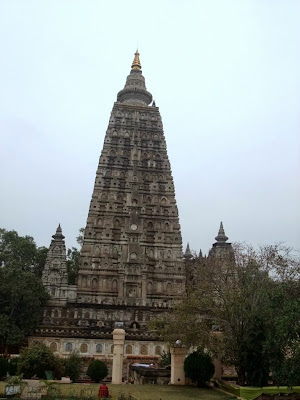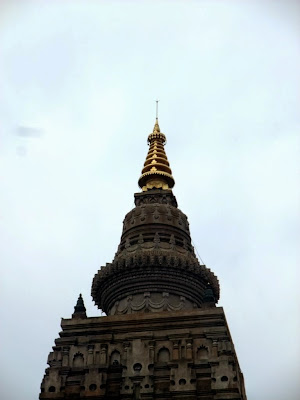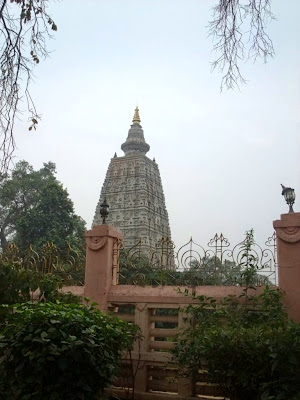
The religious site of Bodhgaya locating by the bank of Neranjana River in Bihar State north east of India, is the most sacred Buddhist pilgrimage site in the world. It was known as Uruvela in the past and was the place where Lord Buddha attained enlightenment and became Buddha. Prince Siddharta Gautama (563-483BC) of Sakya Kingdom, at the age of 29, renounced his family and left home to seek for universal truths. He traveled, meditated and practiced severe penances for 6 years along with five ascetics. Long period of starving, Prince became ailing, feeble and sick. Realizing that extreme asceticism did not work, he began to reconsider the path. He bathed himself in River Niranjara and ate the rice milk offered by a village woman named Sujata. He stayed in a Sal Grove for a day and went on to sit under a Peepal Tree in the evening, meditating. On the night of this full moon day of Visakha month, The Prince was enlightened with supreme and perfect insight and became The Awaken One. The grand Mahabodhi Temple complex marks the site of Buddha's enlightenment and celebrates the birth of Buddhism.




Mahabodhi Temple complex built in 5th-6th century standing on the site of the first Bodhgaya shrine originally constructed by King Ashoka in 3rd century BC, comprises the Grand Mahabodhi Temple, Vajrasana Shrine Hall, Holy Bodhi Tree, and other six sacred sites relating to Buddha's enlightenment. The complex was surrounded by numerous ancient votive stupas and protected by inner and outer circular boundaries.



The existing structure of Mahabodhi Temple was restored in 1880s basing on a miniature model unearthed during excavation. Old bricks from the oldest parts were used and fitted with cement onto the building. Funds were raised by many international sectors, oversea Buddhists societies and devotees. It is the most important and holiest place among the four main Buddhist pilgrimage sites in India.



There is a little forecourt at the east entrance leading to the door way of Mahabodhi Temple. Holding in hands, a 3-pieces set of auspicious robes, a bundle of lotus flowers and a bag of fruits, I was getting ready to enter into the little shrine hall of Mahabodhi Temple to make offerings.


The gateway to the main Temple at the central path after flight of steps from east entrance, was originally built by King Asoka in 3rd century but was restored later.




The left pillar with some ancient carvings is the original pillar remained from the original gateway built by King Asoka in 3rd century.



Buildings along the side of central path way houses several images of Buddha and Bodhisattva like Goddess of Mercy.



Memorial to Hindu Mahant who had lived on the site during 15th to 16th century, were at the other side of the central pathway.



The grand Mahabodhi Temple is an imposing brick structure sitting on a quadrangular base with four spires at corners. Measuring at a height of 54 meters, the giant pyramidal structure can be easily recognized from far distance and distinguished from other buildings.



Mahabodhi Temple, being one of the earliest temple from late Gupta period (6th century) built entirely in brick still standing in India, has great influence in the development of brick architectures over the centuries.



A portion of originally erected Asoka Pillars found near Gaya, was moved to south east corner of Mahabodhi temple in year 1956



Mahabodhi Temple had gone through several restoration and renovation in 6th, 7th and 11th century since it was built. But after Buddhism declined in India in 12th to 13th century, temples and shrines at site fell into ruins and abandoned. Attempts only made 500 years later to restore its arts and architectures and revived its place as a pilgrim center. Today it is the most significant Buddhist pilgrimage center on earth.




The constructed structure of Mahabodhi Temple followed the classic style of ancient Indian architecture. It has a low basement with moldings decorated with honeysuckle shrubs and geese designs. Series of niches enshrined with Buddha images are above the basement, followed by moldings and chaitya niches at further top layer. The highest part of the building is surmounted with Indian tradition features.



Tower of Mahabodhi Temple is surmounted by Amalaka and Kalasha which are the common features in tradition Indian styled temples.



Mahabodhi Temple Buddhist site has finally listed into world heritage site declared by UNESCO in year 2002.




Flowers boys are every where outside the entrance gate. Since the explosion happened near Mahabodhi Temple years ago, the security of this sacred site are super tight. Three checking points in one entrance and strictly no cell phones.


Hundreds and hundreds of locals are flocking into the site. Are they coming to pay homage, to get inspired or to reduce negative Karma, we wonder.


